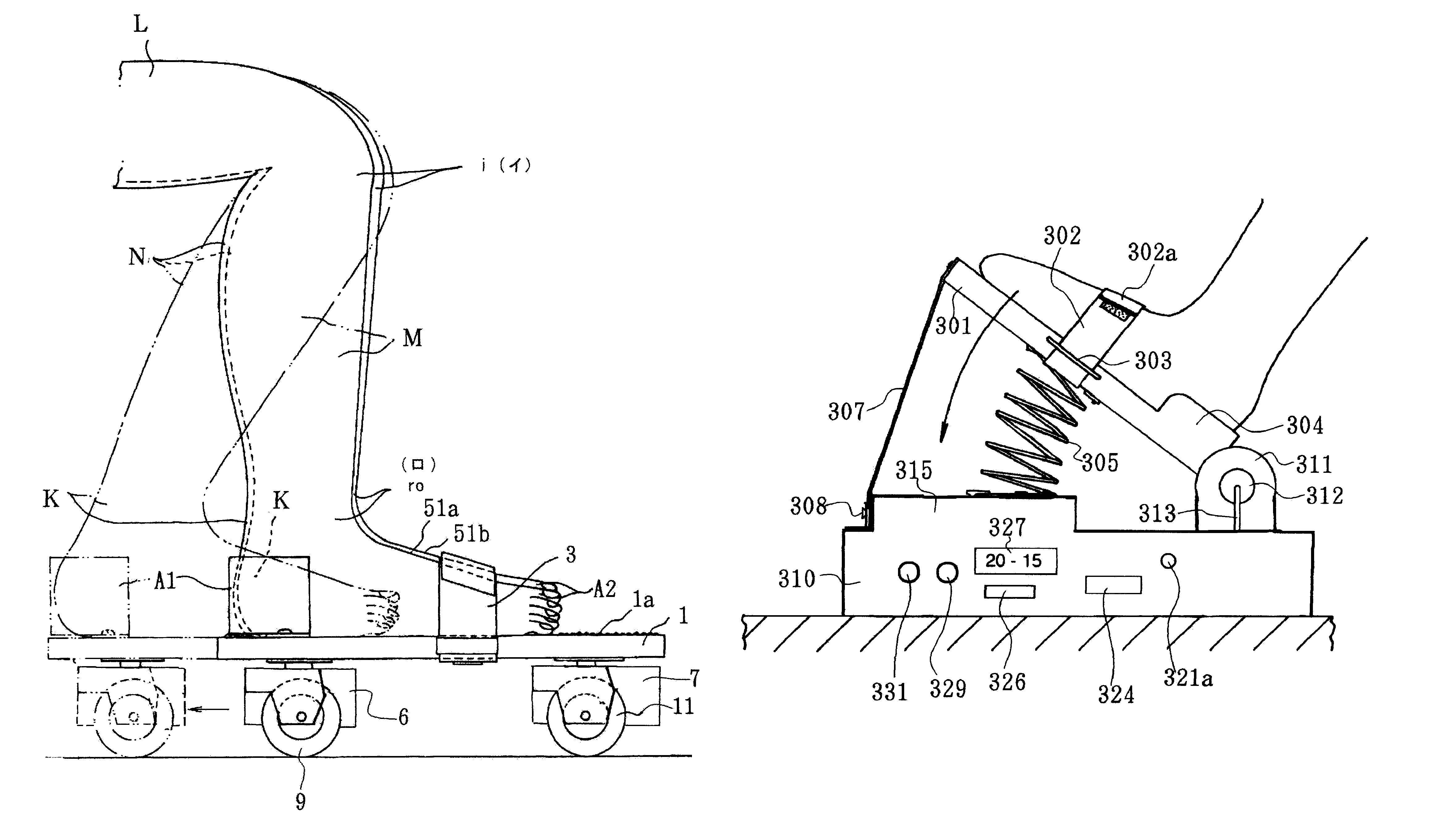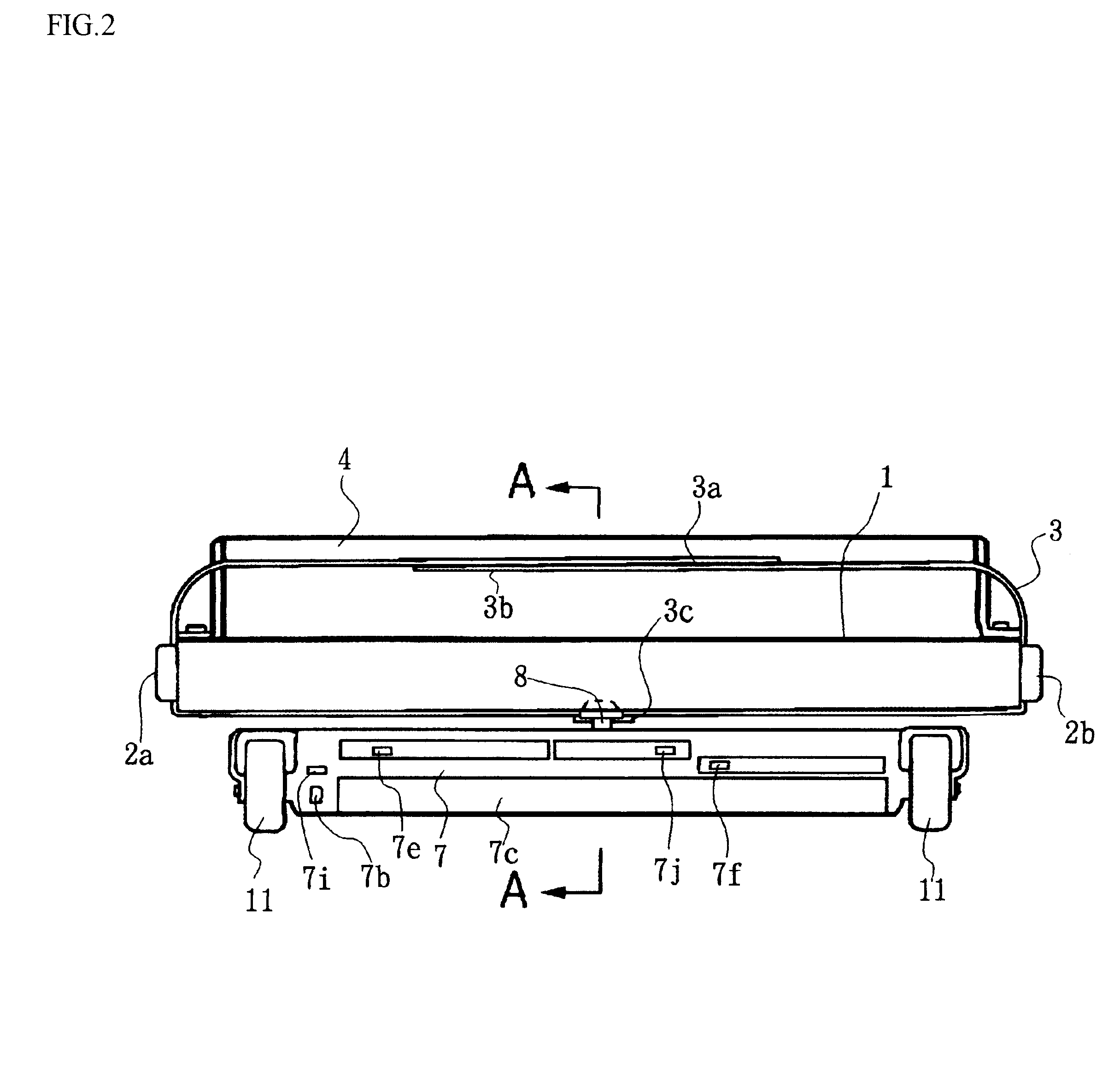Lower limb function training device
a training device and lower limb technology, applied in the field of lower limb function training devices, can solve the problems of difficulty in performing passive exercises at one's convenience, many times of suitable exercise not achieving the expected improvement, and the disabled person who does not perform passive exercises
- Summary
- Abstract
- Description
- Claims
- Application Information
AI Technical Summary
Benefits of technology
Problems solved by technology
Method used
Image
Examples
first embodiment
I explain a lower limb function training device in this invention by using FIG. 1 and FIG. 8.
FIG. 1 is a perspective view of a lower limb function training device of the first embodiment.
FIG. 2 is a front view of FIG. 1.
FIG. 3 is a rear view of FIG. 1.
FIG. 4 is a A--A cross section view of FIG. 2.
FIG. 5 is a side view while using, which sets and fixes the two legs.
FIG. 6 is a side view showing the state of performing Plantar Flexion exercise.
FIG. 7 is a control circuit diagram.
FIG. 8 is a flowchart in case, which the connection between a wheel and a motor are cut.
Furthermore, the drawing of a rear wheel support parts of a right and left part is omitted in FIG. 2.
Also, the drawing of the front wheel support parts is omitted in FIG. 3.
A foot rest (1) is formed with wood in midair with a plane abbreviation rectangular (or embracing necessity plastic etc.).
The foot rest (1) is having an area of sufficient width that can put both feet (51a, 51b) (for example, the size of the side of abou...
second embodiment
The second embodiment consists of a foot rest (1) and a foot rest cart (22) as a measuring instrument, and the similar functions to the first embodiment are realized by combining a foot rest (1) and a foot rest cart (22).
Same as the first embodiment, both a heel support part (4) and setting band (3) assemble a foot rest (1) of this embodiment.
Several proper pieces of wheels (21) that may move toward the right and left freely assemble an undersurface of a foot rest (1).
The lower limb function training device needs to restrict the movement in the right-and-left direction in order to detect the movement in a cross direction and to use.
However, same as the first embodiment, the progression of an exercise tends to deflect the foot (51a) with disability because of the strength of another healthy foot (51b) without any disability is strong due to setting both a foot (51a) with disability and another healthy foot (51b) without any disability.
In this case, it becomes a corrective exercise in...
third embodiment
Next, I explain the third embodiment by using FIG. 14 and FIG. 17.
FIG. 14 is a side view of a lower limb function training device of the third embodiment.
FIG. 15 is a perspective view of FIG. 14.
FIG. 16 is a side view while in use, which sets and fixes the two legs.
FIG. 17 is a side view of the modification of the third embodiment,
(a) is a view of the first modification,
(b) is a view of the 2nd modification.
A foot rest (301) is formed of plastic (or can necessarily be made of wood, etc.) and empty inside with a plane similar to a rectangle.
The foot rest (301) has an area of sufficient width that can set both feet shown as FIG. 16 (for example, the size of the side about 20 cm and about 25 cm, length).
Therefore, a disabled person can set both a foot with a disability, which has hemiparesis of lower extremities of a nerve, decline of the lower extremities muscular strength that originates from a plasmotomy of Achilles' tendon of any lower extremity, a disability in range of motion, et...
PUM
 Login to View More
Login to View More Abstract
Description
Claims
Application Information
 Login to View More
Login to View More - R&D
- Intellectual Property
- Life Sciences
- Materials
- Tech Scout
- Unparalleled Data Quality
- Higher Quality Content
- 60% Fewer Hallucinations
Browse by: Latest US Patents, China's latest patents, Technical Efficacy Thesaurus, Application Domain, Technology Topic, Popular Technical Reports.
© 2025 PatSnap. All rights reserved.Legal|Privacy policy|Modern Slavery Act Transparency Statement|Sitemap|About US| Contact US: help@patsnap.com



